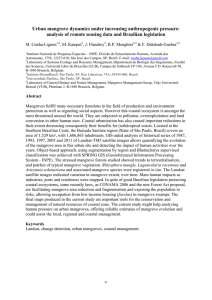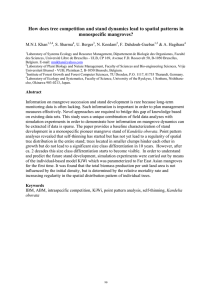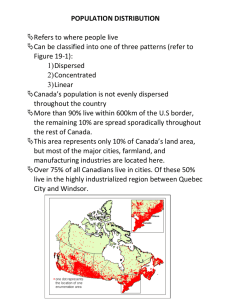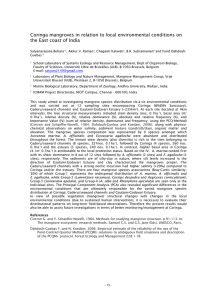Satellite remote sensing and GIS to assess anthropogenic pressures and... mangrove forest management: a case study at the São Francisco...
advertisement
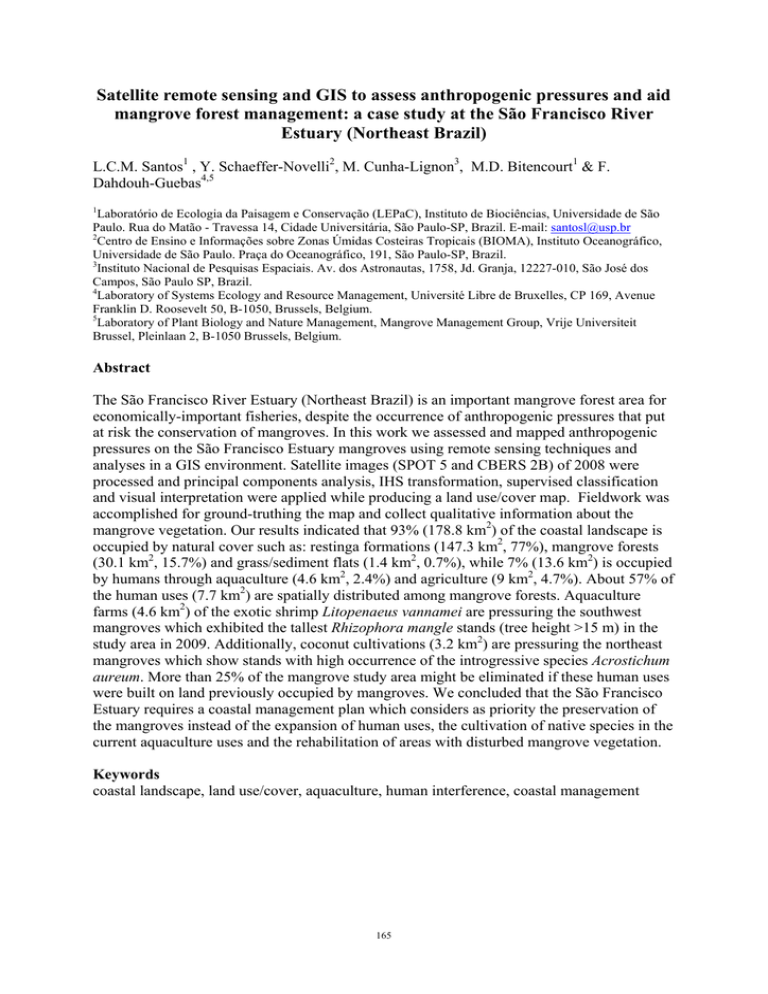
Satellite remote sensing and GIS to assess anthropogenic pressures and aid mangrove forest management: a case study at the São Francisco River Estuary (Northeast Brazil) L.C.M. Santos1 , Y. Schaeffer-Novelli2, M. Cunha-Lignon3, M.D. Bitencourt1 & F. Dahdouh-Guebas4,5 1 Laboratório de Ecologia da Paisagem e Conservação (LEPaC), Instituto de Biociências, Universidade de São Paulo. Rua do Matão - Travessa 14, Cidade Universitária, São Paulo-SP, Brazil. E-mail: santosl@usp.br 2 Centro de Ensino e Informações sobre Zonas Úmidas Costeiras Tropicais (BIOMA), Instituto Oceanográfico, Universidade de São Paulo. Praça do Oceanográfico, 191, São Paulo-SP, Brazil. 3 Instituto Nacional de Pesquisas Espaciais. Av. dos Astronautas, 1758, Jd. Granja, 12227-010, São José dos Campos, São Paulo SP, Brazil. 4 Laboratory of Systems Ecology and Resource Management, Université Libre de Bruxelles, CP 169, Avenue Franklin D. Roosevelt 50, B-1050, Brussels, Belgium. 5 Laboratory of Plant Biology and Nature Management, Mangrove Management Group, Vrije Universiteit Brussel, Pleinlaan 2, B-1050 Brussels, Belgium. Abstract The São Francisco River Estuary (Northeast Brazil) is an important mangrove forest area for economically-important fisheries, despite the occurrence of anthropogenic pressures that put at risk the conservation of mangroves. In this work we assessed and mapped anthropogenic pressures on the São Francisco Estuary mangroves using remote sensing techniques and analyses in a GIS environment. Satellite images (SPOT 5 and CBERS 2B) of 2008 were processed and principal components analysis, IHS transformation, supervised classification and visual interpretation were applied while producing a land use/cover map. Fieldwork was accomplished for ground-truthing the map and collect qualitative information about the mangrove vegetation. Our results indicated that 93% (178.8 km2) of the coastal landscape is occupied by natural cover such as: restinga formations (147.3 km2, 77%), mangrove forests (30.1 km2, 15.7%) and grass/sediment flats (1.4 km2, 0.7%), while 7% (13.6 km2) is occupied by humans through aquaculture (4.6 km2, 2.4%) and agriculture (9 km2, 4.7%). About 57% of the human uses (7.7 km2) are spatially distributed among mangrove forests. Aquaculture farms (4.6 km2) of the exotic shrimp Litopenaeus vannamei are pressuring the southwest mangroves which exhibited the tallest Rhizophora mangle stands (tree height >15 m) in the study area in 2009. Additionally, coconut cultivations (3.2 km2) are pressuring the northeast mangroves which show stands with high occurrence of the introgressive species Acrostichum aureum. More than 25% of the mangrove study area might be eliminated if these human uses were built on land previously occupied by mangroves. We concluded that the São Francisco Estuary requires a coastal management plan which considers as priority the preservation of the mangroves instead of the expansion of human uses, the cultivation of native species in the current aquaculture uses and the rehabilitation of areas with disturbed mangrove vegetation. Keywords coastal landscape, land use/cover, aquaculture, human interference, coastal management 165
